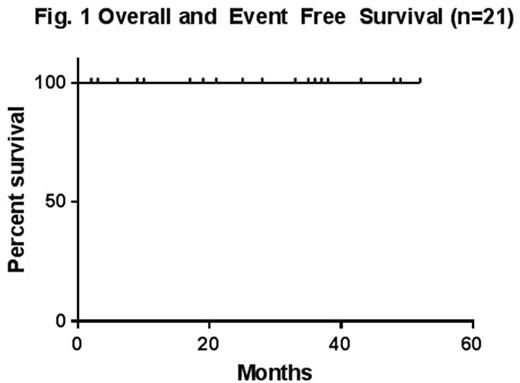Abstract
Background: Cure rates for children, adolescents and young adults with Hodgkin Lymphoma remain high, however are limited by significant short and long term toxicity of chemotherapy including effects on cardiac, pulmonary, endocrine and fertility functioning as well as a high rate of secondary malignancy (Canellos GP et al. J Clin Oncol. 2014; 32(3): 163-8; Hochberg J et al. BJH 2009; 144(1):24-40). These effects are compounded by the addition of radiation to therapeutic regimens. Immunotherapy targeting both the Reed Sternberg cell as well as the tumor microenvironment has potential benefit in being able to reduce the burden of traditional chemoradiotherapy treatment. Brentuximab Vedotin and Rituximab have both shown efficacy in relapsed Hodgkin Lymphoma (Younes A et al. J Clin Oncol. 2012; 30(18): 2183-9; Younes A et al. Blood. 2012; 119(18): 4123-8) and are being investigated in up front adult HL clinical trials. We hypothesized that the addition of Brentuximab vedotin (Bv) and Rituximab (R) combined with risk adapted chemotherapy will be safe, well tolerated and effective in children, adolescents and young adults with all stages of newly diagnosed Hodgkin lymphoma while preserving excellent current event free survival with elimination of more toxic chemoradiotherapy.
Objectives: To evaluate the safety, tolerability and overall response rate of Brentuximab vedotin and Rituximab in combination with risk adapted chemotherapy in children, adolescents and young adults with newly diagnosed Hodgkin Lymphoma.
Methods: Prospective Phase II, non-randomized, risk assigned study (NCT02398240). Eligible patients age 1-30 years with all stages of newly diagnosed classical Hodgkin Lymphoma. Low risk (Stage IA, IIA) patients were given 3 cycles of chemoimmunotherapy consisting of Brentuximab vedotin with Doxorubicin, Vincristine, Prednisone and Dacarbazine (Bv-AVPD). Intermediate (Stage IA bulk/E, IB, IIA bulk/E, IIB, IIIA) and High Risk (Stage IIIA bulk/E, IIIB, IVA/B) patients received either 4 or 6 cycles of Brentuximab vedotin, Doxorubicin, Vinblastine, Dacarbazine and Rituximab (Bv-AVD-R). Early response was measured by PET/CT scan following 2 cycles of chemoimmunotherapy. Definition of Rapid Early Response was PET negative (Deaville ≤2) CR after completion of 1 cycle of chemotherapy for low risk patients and 2 cycles of chemotherapy for intermediate/high risk patients. Slow responders received an additional 2 cycles of Bv-AVD-R for Intermediate Risk or Ifosfamide/Vinorelbine for High Risk patients. Radiation therapy was given ONLY to those patients not in CR at the completion of chemoimmunotherapy, or patients with bulky disease at presentation and found to have a slow early response.
Results: Total enrolled to date = 23 patients. Median age = 15yr (range 4-23yr). Total 8 males, 15 females. B symptoms present in 11 patients. Bulky disease at diagnosis in 5 patients. Risk Assignment = 3 low, 13 intermediate, 7 high. Therapy was overall well tolerated with only 3 Grade III or greater toxicity events - 1 episode of GrIII mucositis, 1 episode of GrIII infusion reaction to Brentuximab vedotin, 1 episode GrIII peripheral neuropathy. All Grade III toxicities resolved to <Grade II with appropriate dosing/administration adjustments. Twenty one patients have completed therapy. All 21 patients achieved a complete response to chemoimmunotherapy for a CR = 100%. All 23 patients have been assessed for early response. Twelve (52%) have achieved a rapid early response. One patient has required radiation therapy to date due to the presentation of bulky disease with a slow early response. This patient was in CR prior to the start of radiation. For 21 patients who have completed therapy, the EFS and OS is 100% with a median follow up time of 943 days (32months). (Figure 1)
Conclusions: The addition of Brentuximab vedotin and Rituximab to combination risk adapted chemotherapy for newly diagnosed Hodgkin Lymphoma appears to be safe in children, adolescents and young adults. Our early results show significant promise with a CR rate of 100% and 52% rapid early response. We have successfully deleted cyclophosphamide, etoposide, bleomycin and radiation from this treatment regimen. The EFS/OS to date is 100% with a median follow up time of close to three years. Further follow up and a larger cohort is needed to determine long term outcomes of this approach.
Cairo: Jazz Pharmaceuticals: Speakers Bureau.
Author notes
Asterisk with author names denotes non-ASH members.


This feature is available to Subscribers Only
Sign In or Create an Account Close Modal